Nurse Shark Basics

The nurse shark, known scientifically as Ginglymostoma cirratum, is a species of shark that can easily be identified by its large head and small, serrated teeth that are well-adapted for their suction feeding habits. This species is in the family Ginglymostomatidae, which derives from Greek and Latin roots; ‘ginglymos’ meaning “hinge” and ‘stoma’ meaning “mouth” describes their unique mouth structure. The term “nurse shark” is thought to possibly originate from the Old English word “nusse”.
These sharks exhibit a brownish color which can vary from individual to individual. They are typically slow-moving, spending their days resting along the seafloor, often motionless and hidden among the sand, coral, or ledges during daylight hours. Nurse sharks are known for their distinct barbels, which are whisker-like organs near the mouth, enhancing their ability to find prey in the sandy bottoms of their habitats.
Listed as a Vulnerable species on the IUCN Red List, nurse sharks populate the tropical western Atlantic and Eastern Pacific Oceans including areas around the Caribbean, coral reefs, and mangrove islands. They grow to an average length of 7.5 to 9.75 feet and have a lifespan of up to 25 years.
Reproduction among nurse sharks is viviparous, with embryos developing inside the female and live young being born. The gestation period generally lasts around six months, and the juveniles, often born with spotted skin, will lose these spots as they mature.
Despite their name, which may evoke an image of gentleness, divers and scientists acknowledge that these sharks, while usually harmless to humans, should be respected as they are capable of a powerful shark bite if provoked. However, actual attacks on humans are rare. Generally, nurse sharks are considered docile, especially when encountered by humans in their natural environments.
Nurse Shark Diet and Predation

The nurse shark is known for its unique feeding habits, directly influenced by its anatomy. Primarily carnivorous, their diet consists of a variety of bottom-dwelling creatures. In the calm seafloor of the Atlantic Ocean, coral reefs, and mangrove islands, these sharks use their strong jaws complemented by thousands of tiny, serrated teeth to feast on prey such as crustaceans, mollusks, and small fish. Interestingly, unlike other sharks, nurse sharks are suction feeders.
Adaptations like barbels, which are whisker-like organs near the mouth, and their ability to create a strong sucking sound help them locate and devour meals hidden in the sand or within crevices in coral reefs. These sharks are opportunistic and will also consume harder-to-catch sea life, including squid and sea urchins.
Nurse sharks are mostly nocturnal hunters, preferring to search for food during the night and oftentimes resting by day in groups, sometimes piling atop one another. As they scour the sea floor, nurse sharks may inadvertently ingest non-food items like algae and coral, as these can be mixed in with their intended prey. Despite presenting a somewhat lethargic appearance, nurse sharks are calculated and effective hunters.
The nurse shark’s interactions with potential predators are limited due to their size and the depths they inhabit. Larger predators are less common in the nurse shark’s habitat; however, young nurse sharks may be at risk from other shark species. Regarding humans, nurse sharks tend to be docile and pose little threat unless provoked. Consequently, they are a favorite among divers exploring the tropical waters of the eastern Pacific and the Caribbean.

